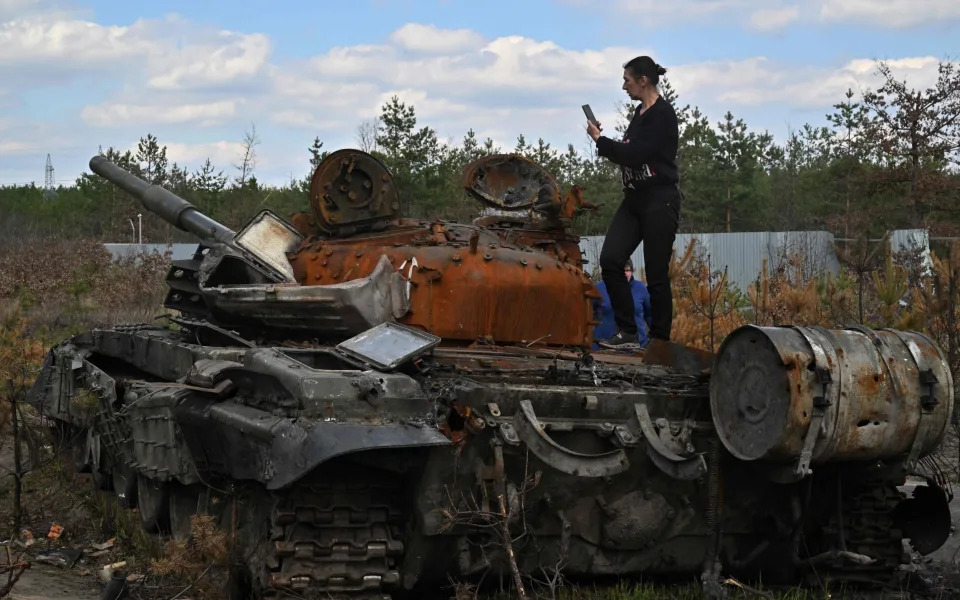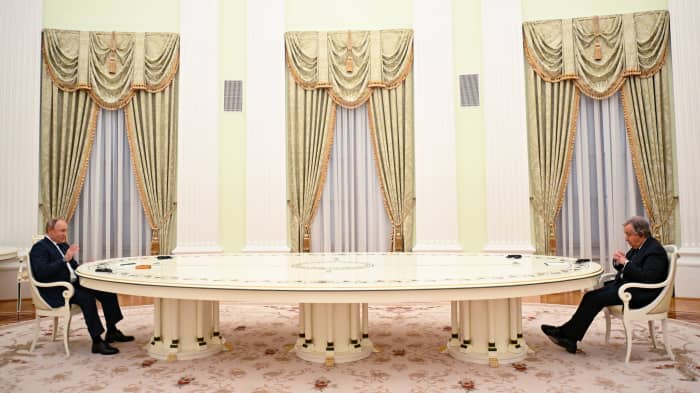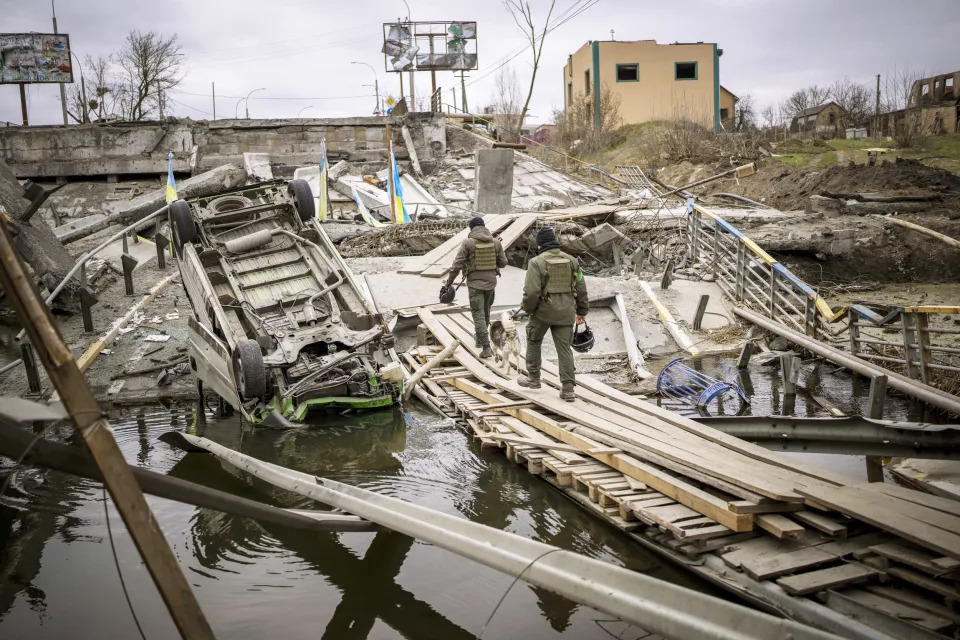Associated Press
Russia strikes back by cutting off gas to 2 NATO nations
Yesica Fisch, Jon Gambrell and Vanessa Gerat – April 26, 2022
POKROVSK, Ukraine (AP) — Russia cut off natural gas to NATO members Poland and Bulgaria on Wednesday and threatened to do the same to other countries, dramatically escalating its standoff with the West over the war in Ukraine. European leaders decried the move as “blackmail.”
A day after the U.S. and other Western allies vowed to speed more and heavier weapons to Ukraine, the Kremlin used its most essential export as leverage against two of Kyiv’s staunch backers. Gas prices in Europe shot up on the news.
The tactic could eventually force targeted nations to resort to gas rationing and could deal another blow to economies suffering from rising prices. At the same time, it could deprive Russia of badly needed income to fund its war effort.
Western leaders and analysts portrayed the move by the Kremlin as a bid to both punish and divide the allies so as to undermine their united support for Ukraine.
Poland has been a major gateway for the delivery of weapons to Ukraine and confirmed this week that it is sending the country tanks. It has also been a vocal proponent of sanctions against the Kremlin.
Bulgaria, under a new liberal government that took office last fall, has cut many of its old ties to Moscow and likewise supported punitive measures against Russia. It has also hosted Western fighter jets at a new NATO outpost on Bulgaria’s Black Sea coast.
The gas cuts do not immediately put the two countries in any dire trouble. Poland, especially, has been working for many years to line up other suppliers, and the continent is heading into summer, making gas less essential for households.
Yet the cutoff and the Kremlin warning that other countries could be next sent shivers of worry through the 27-nation European Union. Germany, the largest economy on the continent, and Italy are among Europe’s biggest consumers of Russian natural gas, though they have already been taking steps to reduce their dependence on Moscow.
“It comes as no surprise that the Kremlin uses fossil fuels to try to blackmail us,” said EU Commission President Ursula von der Leyen. “Today, the Kremlin failed once again in his attempt to sow division amongst member states. The era of Russian fossil fuel in Europe is coming to an end.”
State-controlled Russian giant Gazprom said it was shutting off the two countries because they refused to pay in rubles, as President Vladimir Putin has demanded of “unfriendly” nations. The Kremlin said other countries may be cut off if they don’t agree to the payment arrangement.
Most European countries have publicly balked at Russia’s demand for rubles, but it is not clear how many have actually faced the moment of decision so far. Greece’s next scheduled payment to Gazprom is due on May 25, for example, and the government must decide then whether to comply.
Polish Prime Minister Mateusz Morawiecki told the Polish parliament that he believes Poland’s support for Ukraine and the sanctions against Russia were the real reasons behind the gas cutoff. Bulgarian Prime Minister Kiril Petkov called the suspension blackmail, adding: “We will not succumb to such a racket.”
On the battlefield, fighting continued in the country’s east along a largely static front line some 300 miles (480 kilometers) long.
Russia claimed its missiles hit a batch of weapons that the U.S. and European nations had delivered to Ukraine. One person was killed and at least two were injured when rockets hit a residential neighborhood in Kharkiv.
Western officials, speaking on condition of anonymity to discuss intelligence findings, said Russia has made slow progress in the Donbas region in the east, with “minor gains,” including the capture of villages and small towns south of Izyum and on the outskirts of Rubizhne.
The offensive continues to suffer from poor command, losses of troops and equipment, bad weather and strong Ukrainian resistance, the officials said.
They said some Russian troops have been shifted from the gutted southern port city of Mariupol to other parts of the Donbas. But some remain in Mariupol to fight Ukrainian forces holed up at the Azovstal steel plant, the last stronghold in the city. About 1,000 civilians were said to be taking shelter there with an estimated 2,000 Ukrainian defenders.
Just across the border in Russia, an ammunition depot in the Belgorod region burned after several explosions were heard, the governor said. Explosions were also reported in Russia’s Kursk region near the border, and authorities in Russia’s Voronezh region said an air defense system shot down a drone.
Earlier this week, an oil storage facility in the Russian city of Bryansk was engulfed by fire.
Ukrainian presidential adviser Mykhailo Podolyak hinted at the country’s involvement in the fires, saying in a Telegram post that “karma (is) a harsh thing.”
In other developments:
— The head of the International Atomic Energy Agency, Rafael Grossi, said the safety level at Europe’s largest nuclear plant, now under Russian occupation in Ukraine, is like a “red light blinking” as his organization tries in vain to get access to the Zaporizhzhia power station for repairs.
— Amid rising tensions over gas, Moscow and Washington carried out a dramatic prisoner exchange, trading a Marine veteran jailed in Moscow for a convicted Russian drug trafficker serving a long prison sentence in the U.S.
With the help of Western arms, Ukrainian forces have been unexpectedly successful at bogging Russia’s forces down and thwarted their attempt to take Kyiv. Moscow now says its focus is the capture of the Donbas, Ukraine’s mostly Russian-speaking industrial heartland.
A defiant Putin vowed Wednesday that Russia will achieve its military goals, telling parliament, “All the tasks of the special military operation we are conducting in the Donbas and Ukraine, launched on Feb. 24, will be unconditionally fulfilled.”
Simone Tagliapietra, senior fellow at the Bruegel think tank in Brussels, said Russia’s goal in cutting off the flow of gas is to “divide and rule” — pit European countries against one another as they cast about for energy.
While Poland gets around 45% of its gas from Russia, it is overwhelmingly dependent on coal and said it was well prepared for the cutoff. It has ample gas in storage and will soon benefit from two pipelines coming on line, analyst Emily McClain of Rystad Energy said.
Bulgaria gets over 90% of its gas from Russia, but it could increase imports from Azerbaijan, and a pipeline connection to Greece is set to be completed later this year.
Europe is not without its own leverage since, at current prices, it is paying some $400 million a day to Russia for gas, money Putin would lose in a complete cutoff.
Russia can, in theory, sell oil elsewhere — to India and China, for instance. But it doesn’t have the necessary pipeline network in some cases, and it has only limited capacity to export liquefied gas by ship.
“The move that Russia did today is basically a move where Russia hurts itself,” von der Leyen said.
Gambrell reported from Lviv, Ukraine and Gera reported from Warsaw, Poland. Associated Press journalists Jill Lawless in London, Yuras Karmanau in Lviv, David Keyton in Kyiv, Oleksandr Stashevskyi at Chernobyl, Mstyslav Chernov in Kharkiv, and AP staff around the world contributed to this report.











